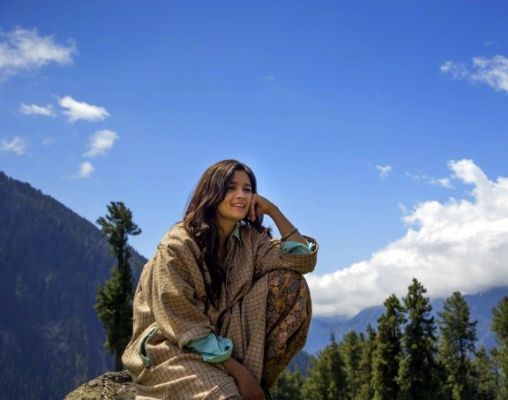Imtiaz Ali’s Highway is a soulful treat to the eyes and the senses. He artfully takes us on an exhilarating visual journey of an India so many of us didn’t know exists. The movie opens to beautifully filmed scenes that capture untouched landscapes in the countryside of Delhi, Punjab, Haryana, Rajasthan, Himachal Pradesh and Jammu & Kashmir.
Veera the rich girl (Alia Bhatt) is chauffeured by her tormentor, Mahabir (Ranbir Hooda) in a rustic old truck. The journey liberates her for an eternity. Away from the hypocrisies of society, she meets sweet freedom in the lap of nature and bathes her soul in the purity of its love.
It all starts when kidnapped Veera, enjoying her morning tea in the midst of salt pans, starts her soliloquy as:
ajjeb jagah hai yeh, meien aisi jagah kabhi ni dekhi, hum jab bhi holiday pe jaate hain saara waqt hotel mein hi rehte hain. Toh faida kya hua, isse accha hum dili ke hotel mein hi check inn kar lein, hotel toh sab jagah ek hi hote hain
What begins as a runaway attempt in Ajmer (Rajasthan) culminates into a road trip leading to a house on a hill, whose windows open to lush green meadows, with gurgling streams lending music for the most romantic setting possible on the Indian screen.
For everyone who discovered this India through Highway, here’s your chance to learn about the places captured through the lens of Imtiaz Ali…. Go on Read for yourselfFaridkot, Punjab

The historic city of Faridkot lies quaintly in the north east of Punjab. Not a mainstream tourist destination for sure, Faridkot truly imbibes an off-beat character. Legend has it that long long ago, during the 13 century, when Mokalsi, grandson of Raja Manj built a fort here, amongst the laborers there was a saint, Baba Farid, who had miraculous powers. Amongst other ways, he would demonstrate his powers by making a basket full of mud float above his head without any visible support. The city thus got its name from Baba Farid.
If today you happen to visit Faridkot, there’s plenty of history you’ll find embedded in the walls of Qilla Mubarak and Raj Mahal. You can visit the beautiful Darbar Ganj, now circuit house. There’s a plethora of Gurudwaras splattering the city. You can visit Guduwara Tibbi Sahib, Gurudwara Godavarisar and if you’re keen, look around carefully, there’s chances you’ll spot Fairy Cottage and Check tower too.
Noor Mahal, Punjab

A part of Jalandhar District in Punjab, Noor Mahal is another historical town rising from the debris of destruction in 1300 AD, to emerge as an important Mughal center. The Mughals named it after Noor Jehan the wife of Emperor Jehangir. Since Noor Jahan spent her childhood in this town, later it was decided to name it after her.
Noor Mahal is also popularly known as “Serai Nurmahal” because of the famous inn by the same name. It was constructed on the orders of Noor Jahan in 1618 AD.
Even today, the city exuberates of oriental charm and attracts visitors from many parts of the country. Yes, it’s off the road and yet, if you want a closer look at Punjab, it’s a must visit.
Ajmer, Rajasthan

You saw Alia get lost in the maze of never ending salt pans in Highway? Guess what – that’s Rajasthan. If you also closely saw Ajmer in the movie, it is shown as a Muslim dominated city. The reason is the presence of the Dargah-e-Sharif, the holiest muslim Dargah in the country.
Geographically Ajmer is an oasis wrapped in green hills of the Aravali Ranges in the backdrop. It is one of India’s most important pilgrim centers. It receives thousands of muslim pilgrims, and being the gateway to Pushkar, Lord Bhrama’s Abode, Hindu devotees also flock the place in equal numbers. During festive celebrations of Urs (commemorating the death anniversary of Saint Moinuddin Chishti), believers travel over long distances from across the globe to pay homage.
Spiti and Rekong Peo, Himachal Pradesh

People call Spiti “Little Tibet” and rightly so. With an average height of 12,250 feet, the alpine Spiti mountains are sparsely dotted with small villages. A typical sight of whitewashed homes clustered around green barley fields with beautiful monasteries perched on crags in the background of rugged and arid landscape is an indication you’re in Spiti.
Accessible for only a part of the year, vehicles ply over the Kunzum La Pass from Manali from July to October. Every year, Spiti is visited by a steady stream of motor cyclists and bikers who lash their machines against the challenging terrain in a whim to overpower nature. These roads are occasionally washed away by rains during the monsoons between Rekong Peo and Nako. You’ll also need “inner line permits” to travel to many places within the district.
Aru Valley, Jammu & Kashmir

Only 12 kms from Pahalgam nestles the spectacular village of Aru. This self-sufficient village is located in the midst of grasslands and with gurgling streams cutting through deep gorges. It serves as the starting point for a trek to Kolahoi glacier. In fact you can walk up to Aru from Pahalgam along a mountain path. Seeing the Kolahoi in the distance binds you in a spell.
Although the place is open all year around for tourists, the best time for visiting remains restricted to nine months, from March to November. During winters the temperature here goes down way below the zero degree mark, and sightseeing is almost an impossibility.

